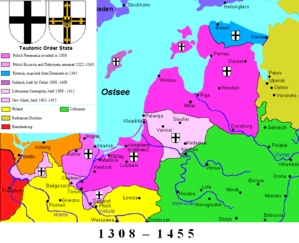Samogitian uprising
| Samogitian uprisings | |||||||
|---|---|---|---|---|---|---|---|
 Map of the Teutonic Knights (in pink) ca. 1455. Samogitia (in very light pink) separated the Teutonic Knights in Prussia from the Livonian Order in the north. For Lithuania (in green) it was the only access to the Baltic Sea. |
|||||||
|
|||||||
| Belligerents | |||||||
|
Samogitia Grand Duchy of Lithuania |
Teutonic Order | ||||||
| Commanders and leaders | |||||||
|
Vytautas Rumbaudas Valimantaitis |
Konrad von Jungingen Ulrich von Jungingen Švitrigaila |
||||||
Samogitian uprisings refer to two uprisings by the Samogitians against the Teutonic Knights in 1401–1404 and 1409. Samogitia was granted to the Teutonic Knights by Vytautas the Great, Grand Duke of Lithuania, several times in order to enlist Knights' support for his other military affairs. The local population resisted Teutonic rule and asked Vytautas to protect them. The first uprising was unsuccessful and Vytautas had to reconfirm his previous promises to transfer Samogitia in the Peace of Raciąż. The second uprising provoked the Knights to declare war on Poland. Hostilities escalated and resulted in the Battle of Grunwald (1410), one of the biggest battles of medieval Europe. The Knights were soundly defeated by the joint Polish–Lithuanian forces, but Vytautas and Jogaila, King of Poland, were unable to capitalize on their victory. Conflicts regarding Samogitia, both diplomatic and military, dragged until the Treaty of Melno (1422).
The Livonian Order was the first to attempt the conquest of Samogitia, but they were decisively defeated by the Samogitians in the Battle of Saule in 1236 and had to become a branch of the Teutonic Order. Continued crusade brought little territorial gains. Samogitia was important to the Knights as it physically separated the Teutonic Knights in Prussia from its branch in Livonia. The first opportunity to acquire Samogitia came only in 1383 when Jogaila formulated the Treaty of Dubysa. The treaty awarded Samogitia up to the Dubysa River to the Knights for their support to Jogaila against Vytautas in the Lithuanian Civil War (1381–84). However, it was not ratified and hostilities between Poland and the Knights broke out soon after. The Knights switched sides and now Vytautas granted Samogitia to the Knights twice – by the Treaty of Königsberg (1384) and Treaty of Lyck (1390). When Jogaila and Vytautas reconciled and broke those treaties, the Knights continued to wage a war against Samogitia and Lithuania. Eventually Vytautas agreed to the Treaty of Salynas, signed in October 1398, as he sought to stabilize the western front while preparing for a large expedition into east against the Golden Horde, resulting in the disastrous Battle of the Vorskla River.
...
Wikipedia
